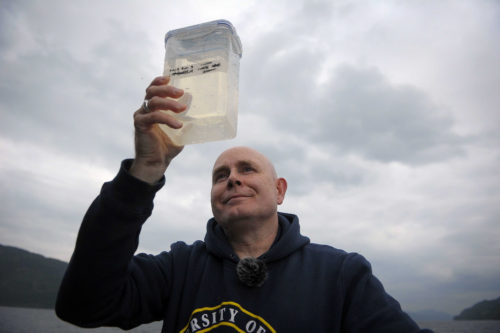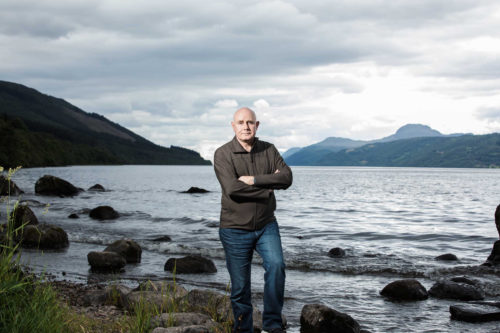
Tales of a monster lurking beneath the waves of Loch Ness have terrified people in the Scottish Highlands for centuries. Dr. Neil Gemmell of the University of Otago in New Zealand used a cutting-edge scientific technique called environmental DNA (eDNA) to unravel this centuries-old mystery. Travel Channel has the exclusive first look at Gemmell’s high-tech monster hunt.
The global premiere of the two-hour special, Loch Ness Monster: New Evidence, premieres in the United States on Travel Channel on Sunday, September 15 at 8 p.m. and in the United Kingdom on Discovery Channel on Sunday, September 15 at 7 p.m.
The Investigation
Gemmell and his team carried out experiments, talked to eyewitnesses and investigated the incredible history of the Loch Ness monster. They collected water samples from all over the loch, which were filtered for DNA fragments.
If there’s monster DNA in the loch, Gemmell will find it. He’ll put the leading theories to the ultimate scientific test. Is Nessie a giant sturgeon or catfish as many contend? Could it be a new, undiscovered species of large eel? Is it a lost relic of the dinosaur era that captured the world’s imagination in the infamous, black and white “Surgeon’s Photo,” taken in 1934?
Gemmell’s stunning evidence is sure to launch a new chapter in the search for the Loch Ness monster. On September 5, 2019, Dr. Gemmell and his team announced the results of their astonishing study.
|“Our cameras have been behind the scenes capturing all of the drama and finally revealing that several leading theories can be scientifically dismissed. Now, the most thorough eDNA study of the loch in history will have its day in the spotlight,” said Matthew Butler, general manager, Travel Channel.

History of Loch Ness Investigations
The scientific community has long been fascinated with the secrets of Loch Ness. Each expedition utilized the best technology of its day to find evidence of the monster.
There were photographic studies in the 1930s. There was even the formation of the Loch Ness Investigation Bureau, which at one point had over 1000 active members. For nearly all of the 1960s, they surveilled the Loch around the clock in search of the monster
In the 1970s, the search incorporated the widespread use of submersibles and submarines. In the 1980s, techniques advanced to sonar searches.
Shining a Light on the Loch
The special spotlights the multiple expeditions of naturalist Adrian Shine. Shine first captured the public imagination with his 1973 expedition. He used a homemade submersible to explore the depths of Loch Ness in hopes of finding evidence of the monster. Spectacular archival footage of this expedition survives to this day.
In 1987, Shine conducted an even more ambitious expedition –Operation Deepscan– a complete sonar mapping of Loch Ness. Something mysterious was detected at a depth of nearly 600 feet –though no one could say precisely what it was.
Throughout the special, Dr. Shine provides historical context for Nessie research throughout the years. He also joins Dr. Gemmell to collect samples in this new eDNA undertaking.
Not a Hoax?
The documentary explores over-the-top hoaxes that fooled the world. For the first time ever, it casts doubt on the claim that the world-famous Surgeon’s Photo was a hoax.
There is new, compelling information –presented by world-famous cryptozoologist Loren Coleman– suggesting the claim the Surgeon’s Photo is a hoax was itself a complete con. Perhaps even an act of revenge contrived by the family of a dishonored Nessie Hunter.
The Loch Ness Project
The film also presents new video evidence provided by eyewitnesses who spotted something inexplicable in the water. The one-of-a-kind location is the ideal backdrop to look back on the science of what has been discovered over time, and the incredible cast of local characters who will go to the grave claiming they’ve seen a great beast.
Professor Gemmell made it clear from the start that the monster myth was always, “the bait on a very large science hook.”
“Perhaps the most lasting legacy of this adventure will be that millions of people now know about the power of eDNA to understand, monitor and protect our environment.”
Gemmell adds he hopes his recent foray to Loch Ness may inspire others to explore the world in this new way.
Explore More
Check out Loch Ness Monster: New Evidence on TravelChannel.com for more, including special show extras, behind-the-scenes photos and exclusive videos.
Follow @TravelChannel and #LochNessNewEvidence on Facebook, Twitter, Instagram for additional content and updates.
Follow Dr. Neil Gemmell on Twitter to learn more about the Loch Ness Project.
Courtney Mroch is a globe-trotting restless spirit who’s both possessed by wanderlust and the spirit of adventure, as well as obsessed with true crime, horror, the paranormal, and weird days. Perhaps it has something to do with her genes? She is related to occult royalty, after all. Marie Laveau, the famous Voodoo practitioner of New Orleans, is one of her ancestors. That could also explain her infatuation with skeletons.
Speaking of healing, to learn how she channeled her battle with cancer to conjure up this site, check out HJ’s Origin Story.

Lake monsters fascinate me. The only “monster” I’ve seen was a beluga whale out of place (left the ocean and went up a river where I was on a fishing trip). I think a lot of lake monsters could be misplaced animals like my whale sighting. But I don’t know about Loch Ness. That seems like something else entirely.
I love this. I wonder how much is just hopeful expectation at seeing something? I kept my eyes peeled when we traversed the waters of Loch Ness, but Nessie didn’t oblige us with a sighting that day…or whatever it may be that people mistake Nessie for.